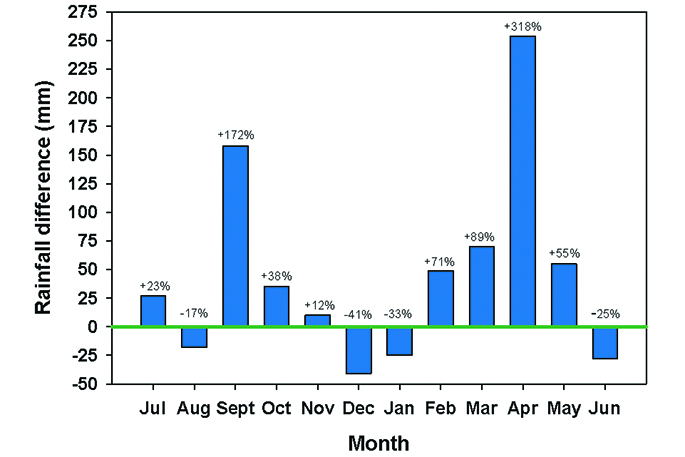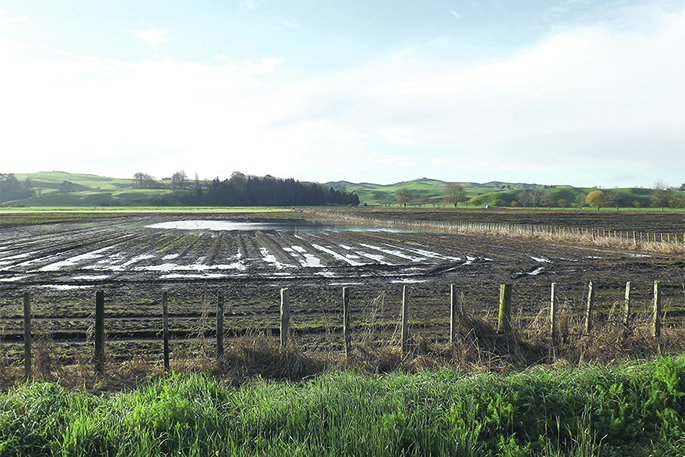Nearly six months of continuous wet weather and surface flooding will have a major impact on some Bay of Plenty and Waikato farms and spring crop establishment will be a long slow process, says Allister Holmes, research and extension team leader with the Foundation for Arable Research. “Soil is made up of solids, liquids and air, but when surface water doesn’t dry off, eventually air spaces become so wet earthworms die and the soil pores collapses.” Allister says many hectares of farm land in the Waikato, especially around Hinuera and Ngatea, plus those affected by flooding in the Eastern Bay of Plenty, have remained under water since Cyclones Debbie and Cook in April this year. “Even soils on rolling farmland which are normally free draining, have become saturated and by September, many regions have already had around their total rainfall for the year.” Planting delays Wet conditions have made it hard for all farmers managing livestock and could also delay this season’s maize planting, Allister says. “In some parts of the Eastern Bay of Plenty, growers have been able to turn over paddocks ready for planting, but there is little sign of that happening in the Western Bay of Plenty or Waikato. “Many consider October 10-20 as the critical dates for planting maize but it is more important for growers to look at ground conditions under their feet before sowing, rather than focusing on a particular date.” Despite how wet some soils were, Allister says five days of sunshine and breezes would help dry them out, however, growers shouldn’t rush to get machinery on the paddocks. “While it’s natural to want to cultivate the soil to get air into it once it appears dry enough to drive on, deeper down it will still be wet and putting machinery on will create compaction problems.” The answer, he says, is to be patient and allow the soil to drain. Maize hybrids with a shorter maturing time offer options for growers. “Their yield is generally not significantly different to longer season hybrids.” High prices Cultivating the soil prior to planting maize will aerate it and help it recover, but many farmers will probably under-sow pasture to get paddocks back in production. The risk is that while grass will grow and there will be a spring flush, it won’t have the same dry matter content because of the water-logged soils. Indications are that there will be a high demand for maize silage this coming season with some farmers committing to contract prices of up to 25 cents a kg compared to 19 to 20 cents last season. The cost of maize grain has also gone up by $50 a tonne compared to last year. “This is good for maize growers.” Around 100ha of maize in the Whakatane area was not harvested last season because of flooding and some Waikato growers were also unable to make maize silage because of extremely wet conditions Allister predicts that once the weather does improve, contractors are going to be under pressure to get new crops planted. Grass silage Normally by mid to late September contractors would be harvesting grass silage, paddocks would be freshening up ready for spraying out and the cultivation of seed beds for maize planting. “However, some contractors haven’t even been able to get onto paddocks to cut silage. “Most maize growers in the Waikato, Bay of Plenty don’t have their own equipment and rely on contractors to prepare the seed bed and plant the maize, so there’s going to be a lot of pressure to get this work done.” On the plus side, the extreme wet may have killed off black beetles and Argentine stem weevils, but, says Allister, slugs will have loved the conditions. “We know that slugs can kill an entire crop so slug control will be vital. “Maize seedlings are reasonably robust, and so long as we get some fine weather, shouldn’t be affected by bacterial or fungal diseases.” Resilient farming Whether or not this year’s wet weather will become a ‘norm’ is anyone’s guess but Allister says New Zealand has a maritime climate and warming sea temperatures tend to bring more rainfall. “Farmers do need to think about what that may mean and make provisions and plans to help their farms be more resilient in the face of adverse weather.” This can include planting different varieties of crops and pasture species each season, using no-till or low-till planting techniques, and giving consideration to farm infrastructure such as installing larger culverts and putting more metal on races.
Saturday, April 20, 2024
Posted: 2:29pm Monday 16 Oct, 2017 | By Elaine Fisher elaine@thesun.co.nz
Maize silage and grain prices up



0 Comments
Leave a Comment